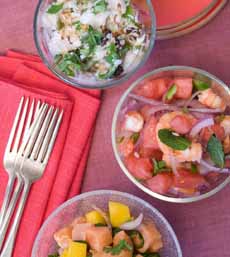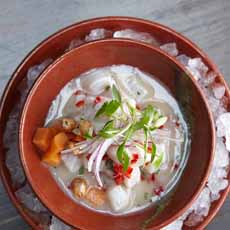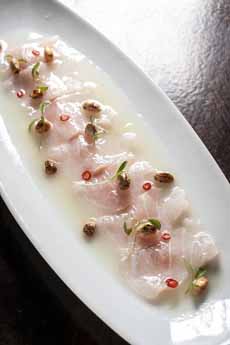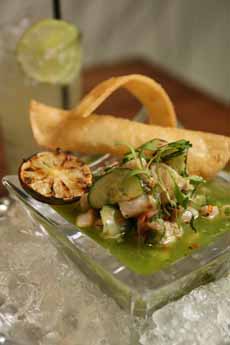FOOD FUN: Deconstructed Ceviche & The Different Types Of Raw Fish Dishes
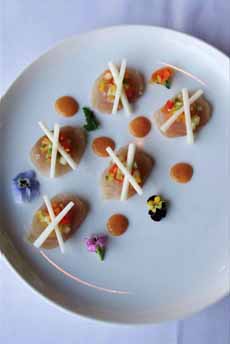 [1] Deconstructed ceviche at Seviche | Louisville.
|
June 28th is National Ceviche Day, so let’s have some fun with it.
Ceviche is delicious “health food.” The history of ceviche and delicious ceviche recipes are below. Seviche Restaurant in Louisville, Kentucky serves a different ceviche any day. While there are traditional presentations, they’ve also served it deconstructed (photo #1). Instead of serving it traditionally—in a bowl or other container, resting in its marinade/curing liquid and topped with garnishes—the deconstruction in Photo #1 comprises: |
|
|
A BRIEF HISTORY OF CEVICHE & TIRADITO In South America, marinated raw fish dishes date to pre-Colombian times, when seafood was “cooked” (acid-cured) with a fruit called tumbo (Passiflora tarminina, a relative of passionfruit). The Incas cured fish in salt and fermented corn. Ceviche—shellfish cured by acidic citrus juice—has been popular in Latin America for many centuries. Read more at: https://www.thenibble.com/reviews/main/fish/seafood/shrimp-ceviche-recipe.asp In the early 1500s, the Spaniards arrived with limes, onions and bell peppers, three essential ingredients in basic modern ceviche. Lime juice cured the fish, and marinating the sliced/diced onions and bell peppers that they mixed in with the seafood. Large kernels of roasted Inca corn were (and still are) a common garnish. A chemical process occurs when the fish/shellfish is marinated in the highly acidic citrus juice, which denatures the protein. The result is similar to what happens when the fish is cooked with heat. Instead of “cooking,” however, the fish is cured in the marinade, which adds its own delicious flavors. Both Ecuador and Peru claim to have originated ceviche: Both were part of the Incan Empire. But why quibble: Today, ceviche—or seviche or sebiche, depending on the country—is so popular that there are cevicherias, restaurants that specialize in ceviche. The term “ceviche” is thought to come from the Spanish escabeche, meaning marinade. Others argue that the word comes from the Quechua (Incan) word siwichi. It may well be, although we could not find this word in the Quechua dictionary we consulted. Ceviche is found in almost all restaurants on the coast of Peru, typically served with camote (sweet potato, which originated in Peru). It has been called “the flagship dish of coastal cuisine,” and is one of the most popular dishes in Peru [source]. Specialty restaurants, called cevicherias, abound. Over time, fruits were incorporated; most popularly, tomatoes (native to Peru) and mango. Today there’s a whole menu of ceviche, using difference types of fish and seafood and country-specific preparations. Each country adds its own spin based on local seafood and preference for ingredients like avocado. Some add a dressing of ketchup or a combination of ketchup and mayonnaise (think shrimp ceviche with cocktail sauce). For example: |
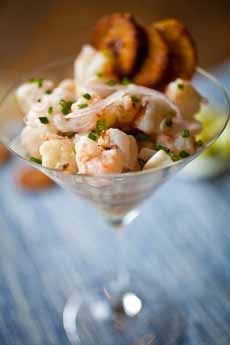 [5] Presentation in a Martini glass with plantain chips, at Elegant Affairs Caterers.
|
|
|
The influx of Japanese immigrants to Peru in the 1970s brought with it chefs who cut and treated the fish in the manner of sashimi. A fusion dish developed called tiradito, with seafood cut sashimi-style (but thinner and longer), a spicy dressing incorporating Peruvian chiles, and more elaborate garnishes. Ceviche is variously spelled with a c or an s, with a v or a b. In Peru, cebiche is the spelling in Lima; although ceviche is used elsewhere in the country, and is the most common internationally. However, seviche was actually declared the proper spelling in 2004, by Peru’s National Institute of Culture. Additionally, historical texts refer to the dish as seviche, including those by the Academia Peruana de la Lengua (Peruvian Language Academy), founded in 1887 [source]. Since even in its homeland, the national dish has multiple spellings, don’t argue with anyone over which one is “correct.” CHECK OUT WHAT’S HAPPENING ON OUR HOME PAGE, THENIBBLE.COM. |
||
